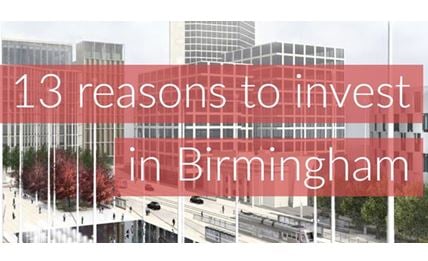
8:34 AM, 3rd September 2018, About 6 years ago
Text Size
The Birmingham story is one that continues to get more and more compelling, and this is why so many investors are looking away from London and toward Birmingham, to achieve long term capital growth, whilst also generating good levels of income.
1. A very ‘Big City Masterplan’ –The 20-year Big City Plan for Birmingham is the most ambitious, far-reaching development project ever undertaken in the UK. As part of this Plan the city is receiving billions of pounds of infrastructure investment, with new tram lines, office blocks and public squares being created as the city is re-modeled. The aim is for Birmingham to become a world-class city.
2. Rail Revolution for Birmingham and the West Midlands – Rail services across Birmingham and the West Midlands are set for a revolution – with journey times slashed and train frequency increasing. Improving rail connections could be worth £649 million a year to the regional economy by 2037, with DOUBLE the amount of trains an hour between Birmingham and Nottingham, Leicester, Hereford and Derby.
3. Infrastructure Investment – The £600m re-development of New Street Station was completed in 2016. The government predict that HS2 will be ready in 2026 at a cost of £55.7bn and will reduce journey times to 49 mins from Birmingham to London. And, a further £100m is to be invested in the city centre Metrolink expansion, which will connect New Street, Curzon Street (HS2) and key city residential hubs.
4. Fastest improving city in the UK –Last year, Birmingham was named fastest-improving city in the UK in which to live and work, which is no surprise with all the recent investment and development the city has attracted. With Birmingham on its upwards cycle of being one of the top cities to invest, live and work, and a host of future development plans in the pipeline, there is no sign of the city slowing down any time soon.
5. Increased demand for Grade A office space –The relocation of core functions from HSBC and Deutsche Bank into the city, have significantly increased the demand for Grade A office space. HMRC will be relocating 3,600 staff to the city in 2020, with Channel 4 and the Bank of England also proposing to relocate in the near future. Ballymore and M&G are investing £200m in over 420,000 sq ft of office space at One Snowhill.
6. Top for Business start-ups – Birmingham has topped the list for the highest number of new start-up businesses outside of London. The main factors contributing to Birmingham’s flourishing entrepreneurial spirit include its world-class accelerator schemes, affordable office space, and access to global markets.
7. House prices grow four times faster – London’s capital growth year-on-year equated to just 1.8%, compared with Birmingham’s chart-topping growth of 7.5%, the highest in England.
8. House prices are three times cheaper – Birmingham house prices average £187,000 against London’s overall average price of over £615,000, according to property portal Rightmove. This means that with lower house prices, Birmingham has a greater potential for appreciation.
9. Four times the space for your money – Birmingham’s average house price will buy you a brand new spacious one-bedroom apartment with parking space in a prime spot in Birmingham city centre. In London, the same spend will buy you a parking space in a prime spot in central London, or a tiny, well-lived studio apartment without parking.
10. Closer to major cities – Birmingham is the most accessible city in the UK. All major cities are reachable within less than four hours, with the capital set to be reachable in under one hour once HS2 launches in 2026. Birmingham Airport is also planning to increase the number of cities it can fly direct to.
11. Student Retention– With 5 universities, Birmingham has over 73,000 UK & Overseas students. The city has seen one of the largest increases in student retention rates in the country, and now sits only behind London in its ability to retain its graduate population.
12. Young population– Birmingham boasts a young populace amongst its citizens, the youngest of any major city in Europe in fact. Under 25s make up 40% of the population and its young demographic lends well to the rental market as many do not have the funds yet to purchase their own homes.
13. Social Hub – Where London may be seen as the ‘fun’ city, Birmingham is on it’s heels with many developments being built on the doorstep of the city’s biggest development in a generation, the Paradise ‘Masterplan’. This will create a vibrant pedestrianised area and 1.8 million square feet of commercial, civic, retail, leisure and hotel space. When considering that city centre properties in Birmingham (both to buy and rent) are plentiful, affordable and supported by a robust shopping and entertainment infrastructure, the pull of Birmingham for businesses and professionals becomes understandable.
Previous Article
Why didn’t Shelter find somewhere for Stephen?Next Article
Sefton Council and the Surveillance State